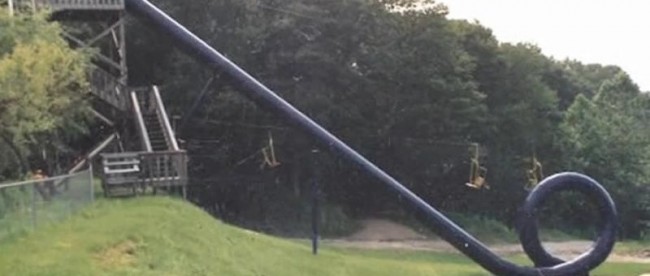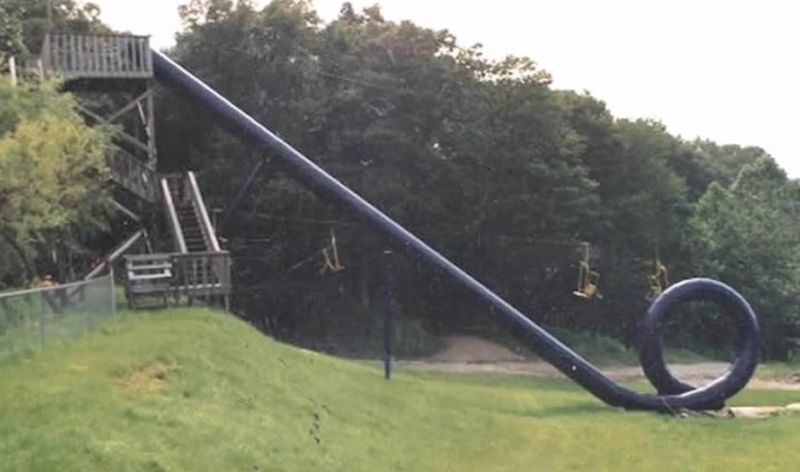New Jersey’s Shockingly Dangerous Water Slide

Every ten years, the United States conducts a census, intending to count every person who lives within its borders. We then get that data a few years later, broken down in many different ways — including by town. From decade to decade, towns populations tend to fluctuate little or grow/shrink steadily, although there are some exceptions. Take Vernon Township, New Jersey, for example. From 1860 to 1930, Vernon’s population fell from 2,190 to 1,279, per Wikipedia, and then grew slowly to 1,548 by 1950. It spiked up to 2,155 in 1960 — and then shot up like a rocket. The 1970 census tallied more than 6,000 people. It more than doubled, to 16,302 in 1980. And finally, in 1990, the town broke the 20,000 person milestone. That’s 10x growth in thirty years after about a century of being basically flat.
The reason for all these new residents? Skiing. In the 1970s, a handful of ski resorts opened up in Vernon Township, attracting visitors and, ultimately, new residents. The problem with skiing, though, is that it’s only a seasonal industry. So one of the resort owners had an idea: open a water park. It makes a lot of sense — the ski area was open during the winter and the water park ran from June until September. With time to switch over in the interim periods, it became a year-round business.
The water park was called “Action Park,” although locals had a different set of nicknames for it: “Traction Park,” “Accident Park,” and “Class Action Park” were all common. That’s because Action Park had a well-deserved reputation for causing injury to its guests. A lengthy retrospective by a website called WeirdNJ summarizes the dangers nicely:
In 1986, the [New Jersey] Herald reported the previous year’s reported accident toll at Action Park: more than 110, including 45 head injuries and 10 fractures. And it is important to stress “reported,” because the park got into a lot of trouble with the state for not reporting accidents.
[ . . . ]
[E]nough injuries occurred that Action Park eventually bought the town of Vernon new ambulances to keep up with the injury volume. In 1987, the Herald also spoke with the director of the ER at a nearby hospital, who said five to 10 people were brought there daily from the park. Injuries included “ankle sprains, cuts and contusions, and…a few broken bones,” with injuries most often occurring “from slipping at swimming pools or cuts from water slides.”
And, over the course of about seven years, at least six people died while using Action Park’s amenities. Yes, most guests played unscathed, plenty came home with bumps, bruises, or worse — but the water park’s nickname was well deserved. And yet, rather than clean up the mess, Action Park doubled down — with this:

That’s a waterslide called Cannonball Loop. It first opened in the summer of 1985.
And it was very, very dangerous.
There were reports of the slide decapitating test dummies and of real people getting stuck at the bottom of the loop having failed to achieve enough momentum to make it around the circle. (Some claim that Action Park installed an escape hatch to deal with this particular problem.) There were lots of bumps, bruises, cuts, and probably concussions; many of the reported maladies are hard-to-substantiate first-hand accounts, but Gizmodo shares a few. For example, there was the employee whose bosses offered him $100 to test the slide. He accepted; but it was his final one, as “$100 did not buy enough booze to drown out that memory.”
And while these stories are perhaps hyperbole, there’s reason to think the slide was unreasonably dangerous: science. Popular Mechanics explains:
The ride’s radical design seems to betray a lack of an understanding of basic physics. To wit: The ride runs through a perfect circle. Early-roller coaster engineers toyed with this design, with disastrous results. The high g-forces that are exerted when entering and exiting the inversion of a perfect circular loop are enough to break a person’s neck (this is why all roller-coaster loops are elliptical or corkscrew-shaped).
There are, thankfully, no reports of any fatalities on Cannonball Loop, but it surely tempted fate. State regulators weren’t going to wait for that to happen; they shut the slide down about a month after it opened.
Bonus fact: As alluded to above, rollercoasters can be dangerous if designed improperly. Take, for example, the “euthanasia coaster,” a (theoretical, don’t worry) design proffered by Julijonas Urbonas , a PhD student in design interactions. Urbonas summarizes the hypothetical theme park ride here (with images of his design), but VICE summarizes how it “works”: “the Euthanasia Coaster starts with a long, slow incline before a quarter-mile fall, which leads into a series of loops that are designed to create so much centrifugal force that you won’t be able to breathe, finally dying from lack of oxygen to your brain. ”
From the Archives: Fore for Five: The tale of a New Jersey town built around golf.
Related: A much safer (?) waterslide for your backyard (??) which costs $500 (???).
